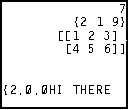| HOME >> Tutorials >> Tutorial 3: Storing & Deleting |
Introduction:
In this tutorial, we will learn how to store and delete different variables including user variables, strings, etc. After I give you the new commands, I will explain what each variable is.
New Commands:
| Stores a value into a variable | |
| DelVar | Deletes from memory the contents of variable |
| L | Used to create new lists |
| dim | Displays the dimension of the list or matrix |
| value |
dim(listname) |
| DelVar variable | dim(matrixname) |
| LListname | length |
| {rows,columns} |
New Variables:
| User Variable | An alpha character in which you can store a number into |
| String | A type of variable in which you can store text |
| List | A type of variable in which you can store a series of numbers |
| Matrix | A two-dimensional array |
Due to questions that I have received from people who have used this tutorial, I feel that I should further explain something. To enter in a matrix you press the ![]() button and choose from the different matrices that are listed. This is explained in the further definition of Matrix, but it seems that it was a problem. You cannot enter a matrix by separately entering the three pieces. You cannot enter "[A]", by pressing "[", "A", and then "]" separately; you must go to the matrix menu.
button and choose from the different matrices that are listed. This is explained in the further definition of Matrix, but it seems that it was a problem. You cannot enter a matrix by separately entering the three pieces. You cannot enter "[A]", by pressing "[", "A", and then "]" separately; you must go to the matrix menu.
The Code:
| : | For AShell, SOS, and TI-Explorer |
| ClrHome | Clears the home screen |
| DelVar B:DelVar Str3 | Deletes the contents of user variable B and Str3 |
| DelVar L2:DelVar [D] | Deletes the contents of L2 and [D] |
| 7 |
Stores 7 into user variable B |
| "HI THERE" |
Stores "HI THERE" into Str3 |
| 3 |
Stores 3 as the length of L2 |
| 4 |
Stores 4 as the length of LTEST |
| {2,3} |
Stores 2x3 as the dimensions of matrix [D] |
| {2,1,9} |
Stores number sequence 2,1,9 into L2 |
| {2,0,0,0} |
Stores number sequence 2,0,0,0 into LTEST |
| [[1,2,3][4,5,6]] |
Stores two-dimensional array into matrix [D] |
| Disp B,L2,[D] | Displays the value of user variable B, L2, and matrix [D] |
| Output(7,1,LTEST) | Displays LTEST starting at row 7 and column 1 |
| Output(7,7,Str3) | Displays Str3 starting at row 7 and column 7 |

Version 2.5 Update:
DelVar is generally not used at the beginning of the programs, but usually at the end. It is used at the end of programs to save ram space. If you delete the contents of a user variable, such as A, it gives you 15 more bytes of free memory. So each time that you delete the contents of a user variable, you add 15 bytes of free memory, which is very vital. Free memory helps your programs run faster and allows you to have more programs. I want to give a special thanks to John Myers, who emailed me giving me this information.
Conclusion:
First of all, notice that Str3 ("HI THERE") overlaps on LTEST {2,0,0,0}. I did this on purpose to show you another example of how Output( overwrites. Also, when you store 4 as the length of LTEST it creates LTEST. If we were to put a :Disp LTEST right after we store 4 as the length of LTEST and ended the program, the output would be {0,0,0,0}. In this tutorial, I also tried to implement everything that we have gone over so far. Storing is a major part of good programming especially, for games. Next, we are going to go on to Conditionals, which are also a major part of good programming.
If you do not understand a particular part in this lesson, have suggestions, or find any problems please contact me.
 |
 |
| Tutorial 2 | Tutorial 4 |